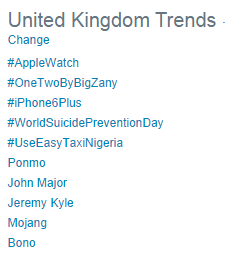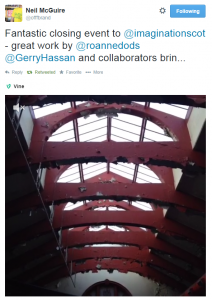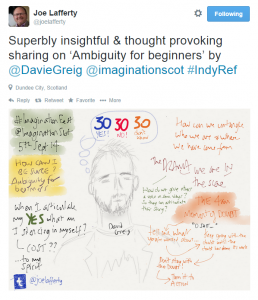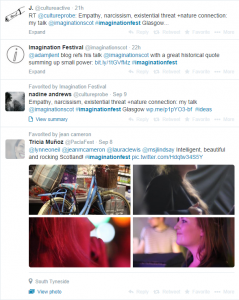
I love live-tweeting events. It’s the perfect digital wallflower activity for creating buzz.
This weekend I lent my smarts and my fast-typing fingers to the Imagination Festival in Glasgow’s South Side.
The event was a 3-day programme rich with fantastic speakers covering areas of ideas, culture, history and politics in Scotland. Independence was discussed, along with topics ranging from ambiguity to gender, violence to empathy, and all topics were discussed with intelligence and humour in the relaxed and welcoming venues The Glad Cafe and Govanhill Baths.
Can you tell I had a great time? More to the point — what was I doing there? The event organisers hired me to make some noise on social media — both to raise awareness of the event and to save some of its highlights for posterity.
Here are my tips for successful live-tweeting.

Part I – Selling It
The key to live-tweeting is to alert your followers and target audience to the event. But it doesn’t begin on the day.
Ideally this begins with a content strategy during the conception of the event, consisting of a marketing phase where information about the event will be shared with the target audience.
In my work, this usually involves content marketing. This stage should should give a sense of what to expect from the event. It should also provide useful content on the topic of the event, as well fulfilling the end game: selling tickets.
Part II – Amplifying It
During the event, this means creating content — usually tweets and short live blogs — to capture the essence of goings-on.
TIP: You have to have a hashtag. You have to advertise it. You have to use it on the official social media presence of the event.
Look at how many of these trending topics are topical events.

Make your hashtag short, and make it easy to understand.
If you have to add a few characters to avoid a random mess of letters and numbers, go for it.
If you can make the hashtag the same as your handle, you’ve hit the jackpot.
Before the Event
Now that you’ve got your hashtag in place and you’ve teased, sold tickets, and reached the opening day, it’s time to get snapping.
TIP: I like to capture a photographs from around the venue. This could be the exterior, a queue of eager attendees, delicious shots of the snacks inside (Imagination Festival’s breakfast caterer Bakery47 are especially adept at this!), and a sneak peek behind the scenes.
During the Event
Now on to the good stuff. Your audience is in place, your speakers or performers are taking the stage, and it’s time to get tweeting.
TIP: Keep your audience in mind: you’re tweeting for an audience inside and outside the venue. Don’t be afraid to narrate a little. As one speaker takes the stage, tweet their name and their topic of choice. Use their handle where you can.
Tweets are short, so try to distil down the speakers’ best points into a tasty tidbit, and get tweeting. I like to grab soundbites as I go and post these as quotes, crediting the speaker by @mention, and adding the hashtag. Voila!

If your audience is primed (and having a good time!) they’ll be tweeting too. Keep tabs open with the hashtag search, your Mentions, and RT a smattering of audience responses.
Make use of their image tweets while you’re stuck at the back of the auditorium. They may even post really creative updates, like Neil’s Vine above. These are all great signs of an engaged audience experience.
FAQ: How many times should I tweet? There really is no upper limit on tweets. Try to be consistent throughout each item on your event schedule. If people know your event is ongoing, they’ll choose whether to follow or unfollow. As long as you can spell it carefully, include
After the Event
After the event, keep tweeting! Sure, it’s no longer live, but it’s still real-time engagement.
By keeping the conversation going, you can ensure that important conversations spurred by your event will continue to thrive.
If it’s a regular event, be sure to keep activity going throughout the off-season. This keeps your brand alive, relevant, and increases all those good things like brand value, advocacy, visibility and awareness. It takes a little time, but it’s totally worthwhile. Don’t surprise your followers by appearing out of nowhere once a year.
Part III – Saving It

As I mentioned above, saving live-tweeting highlights from the event for posterity is a huge part of the live-tweeting process. Save it, share it, and celebrate it!
You wouldn’t want to lose gorgeous content like the above, now, would you?
Tools like Storify are the perfect way to grab highlights and fun content posted live at your event. All you do is sign in, search for your tweets and/or your hashtag, and start dragging your favourite tweets into the timeline to tell your story. For example, Edinburgh Book Festival is especially good at this.
Here is the Imagination Festival Storify by co-organizer Roanne Dods.
TIP: I also like to curate my own Twitter stories by using the Twitter embed code directly into a blog post. Favourite the best posts as you go and grab that embed code later.
Your Turn!
Have you tried live-tweeting events? What has your experience been like?
If you need a hand building social buzz for your own event, click here to get in touch and let’s see if we can work together.
––
Fancy receiving a free monthly newsletter from nicolabalkind.com? Sign up here.

[…] already blogged about The Art of Live-Tweeting – and that’s what I’m going to be doing for the next 2 […]